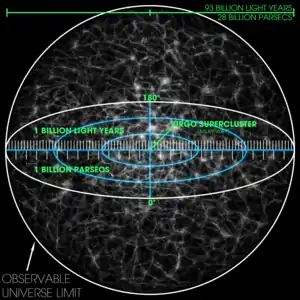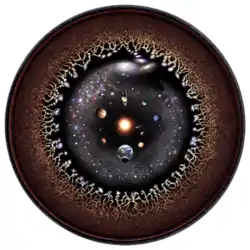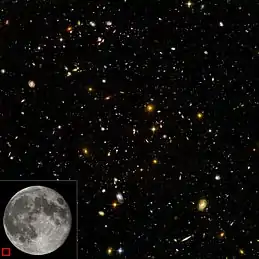လေ့လာနိုင်သော စကြာဝဠာ
လေ့လာနိုင်သော စကြဝဠာ (Observable universe) ဆိုသည်မှာ လူသားတို့အနေဖြင့် စကြဝဠာအား လက်လှမ်းမှီသမျှ လေ့လာ၍ရသည့် စကြာဝဠာတစ်ခုလုံးအား ဆိုလိုသည်။ စကြာဝဠာသည် ပြင်ညီကဲ့သို့ တပြေးညီတည်ရှိသည်ဟုယူဆရင်း လေ့လာသူတစ်ယောက်အနေဖြင့် စကြာဝဠာ၏ မည်သည့်နေရာမှ လေ့လာသည်ဖြစ်စေ အတူတူပင် မြင်ရပေမည်။ ကမ္ဘာမြေမှ လေ့လာနိုင်သော ဂယ်လက်ဆီအရေအတွက်မှာ အနည်းဆုံး ၂ ထရီလီယံ ရှိလေသည်။[7][8] လေ့လာနိုင်သော ဟူသည့်စကားလုံးသည် ခေတ်သစ်သိပ္ပံပညာများအပေါ် မမူတည်ပေ။ ကော့စမစ်နောက်ခံ မိုက်ခရိုလှိုင်းဖြာထွက်မှု (cosmic microwave background radiation: CMBR) အား သိပ္ပံပညာရှင်များ အချိန်ယူကာ တိုင်းတာခဲ့ကြရာ မဟာပေါက်ကွဲမှုကတည်းက ပြန့်ကားလာသည့် စကြဝဠာ၏မြေပုံအား ရေးဆွဲနိုင်ခဲ့သည်။ CMBR မှရလဒ်အားအခြေခံကာ တွက်ချက်မှုများအရ လက်ရှိ မိမိတို့ မြင်နိုင်သမျှ အလင်း၏အကွာအဝေးသည် ၁၄ ဘီလီယံ Parsec (အလင်းနှစ် ၄၅.၇ ဘီလီယံ) ရှိသည်။ ယဉ်တွဲရွေ့လျားအကွာအဝေးသည် ၁၄.၃ ဘီလီယံ Parsec (အလင်းနှစ် ၄၆.၆ ဘီလီယံ) ရှိကာ ၂% ပိုများသည်။[9] စကြဝဠာသည် အချိန်နှင့်အမျှ ပြန့်ကားနေသောကြောင့် ယှဉ်တွဲရွေ့လျားအကွာအဝေး (comoving distance) ဟုသုံးသည်။ ၂၀၁၅ ခုနှစ်အရ စကြဝဠာ၏သက်တမ်းအား အကောင်းဆုံးမှန်းဆချက်မှာ ၁၃.၇၉၉ ±၀.၀၂၁ ဘီလီယံနှစ်ဖြစ်သည်။[5] သို့သော် စကြဝဠာပြန့်ကားမှုအရ လေ့လာနိုင်သောစကြဝဠာ၏အချင်းသည် ၂၈.၅ gigaparsec (အလင်းနှစ် ၉၃ ဘီလီယံ) ရှိသည်ဟုဆိုသည်။ [10] ထို့ကြောင့် လေ့လာနိုင်သော စကြဝဠာ၏ အနားစွန်းသည် အလင်းနှစ် ၄၆.၅ ဘီလီယံ ရှိပေမည်။[11][12]
 လေ့လာနိုင်သော စကြဝဠာအား အကျဉ်းချုပ်သရုပ်ဖော်ထားပုံ၊ အစက်ကလေးများသည် supercluster အစုအဝေးများအား ဖော်ညွန်းပြီး Virgo Supercluster သည် အလယ်ဗဟို၌ တည်ရှိသည်။ ယင်းသည် နဂါးငွေ့တန်း၏ မိခင်ဖြစ်သော်လည်း မြင်သာရန် သေးငယ်လွန်းလှသည်။ | |
| အချင်း | ၈.၈×၁၀၂၆ m (၂၈.၅ Gpc သို့မဟုတ် ၉၃ Gly)[1] |
|---|---|
| ထုထည် | ၄×၁၀၈၀ m3[2] |
| ဒြပ်ထု (ordinary matter) | ၁၀၅၃ kg[3] |
| သိပ်သည်းမှု | ၉.၉×၁၀-၃၀ g/cm3 (အာကာသ၏ ၁ ကုဗမီတာလျင် ပရိုတွန် ၆ လုံးနှင့်ညီမျှသည်)[4] |
| သက်တမ်း | ၁၃.၇၉၉ ± ၀.၀၂၁ ဘီလီယံ နှစ်[5] |
| ပျမ်းမျှအပူချိန် | ၂.၇၂၅၄၈ ကေလ်ဗင်[6] |
| ပါဝင်သော | သာမန် ဘိုင်ယွန်းနစ်အရာဝတ္ထု (၄.၉%) ဒြပ်မည်း (၂၆.၈%) စွမ်းအင်နက် (၆၈.၃%) |
စကြဝဠာ Vs လေ့လာနိုင်သောစကြာဝဠာ

မဟာပေါက်ကွဲမှုကတည်းက ပြန့်ကားသွားသော အဝေးမှဂလက်ဆီများသည် မိမိတို့ဆီရောက်ရန် အချိန်ယူရသည်။ ထို့ကြောင့် အနာဂါတ်တွင် အဝေးမှ ဂလက်ဆီများအား (အရင်က မမြင်ဖူးသော) မြင်တွေ့ရပေမည်။ သို့သော် ယနေ့အခါ၌ စကြာဝဠာသည် စွမ်းအင်နက်ကြောင့် စကြာဝဠာပြန့်ကားနှုန်းသည် အရှိန်တင်၍ ပြန့်ကားနေသည်။ ယခုအတိုင်းဖြင့် ဆက်လက်ပြန့်ကားနေမည်ဆိုပါက အနီရောင်အရွေ့ကြောင့် အဝေးမှ ဂလက်ဆီများသည် မြင်ကွင်းမှ ထာဝရ ပျောက်ကွယ်သွားပေလိမ့်မည်။[13][14] အလန် ဂုထ် (Alan Guth) ၏ စကြာဝဠာဖောင်းပွခြင်းသီအိုရီအရ စကြာဝဠာသည် မဟာပေါက်ကွဲမှုအပြီး ၁၀-၃၇ စက္ကန့်အကြာတွင် စတင်ခဲ့သည်။ ယင်းအဆိုအရ လက်ရှိစကြာဝဠာသည် လေ့လာနိုင်သောစကြာဝဠာထက် အဆပေါင်း ၃×၁၀၂၃ ရှိနိုင်သည်ဟုဆိုသည်။ [15] အချို့ကမူ လေ့လာနိုင်သောစကြာဝဠာထက် အဆပေါင်း ၂၅၀ ရှိသည်ဟုဆိုကြသည်။[16]
ကြယ်များအား ရေတွက်ခြင်းဖြင့် လေ့လာမှု

ကြယ်အရေအတွက်အား တိတိကျကျသိရှိရန် နည်းလမ်းမရှိပေ၊ သို့သော် လက်ရှိအသိပညာဖြင့်ဆိုပါက သာမန်အားဖြင့် ၁၀၂၂ မှ ၁၀၂၄ ရှိလေသည်။[17][18][19][20] ယင်းအတိုင်းအတာပမာဏအား ပြေလည်စေရန် နည်းလမ်းတစ်ခုမှာ ဂယ်လက်ဆီတို့၏ အရေအတွက်အား ခန့်မှန်းရန်ဖြစ်ပြီး ဂလက်ဆီတစ်ခုချင်းစီတွင် ပါဝင်သော ပျမ်းမျှကြယ်အရေအတွက်ဖြင့် မြောက်ရန်ဖြစ်သည်။ ၂၀၀၄ ခုနှစ် Hubble Ultra-Deep Field ပုံရိပ်အရ ခန့်မှန်းခြေ ဂလက်ဆီမှာ ၁၀,၀၀၀ ဖြစ်သည်။[21] နှိုင်းယှဉ်ရသော် ယင်းမှ ဖမ်းမိသည့် ကောင်းကင်၏ ဧရိယာသည် တစ်ဘက်စီတွင် ၃.၄ arc minutes ရှိသည်။ ထိုပုံရိပ်များသည် လပြည့်ဝန်းအရွယ်အစားနှင့် ကာမိစေရန် ပုံပေါင်း ၅၀ ကျော်လိုအပ်ပေလိမ့်မည်။ ယင်းဧရိယာသည် ကောင်းကင်တစ်ခုလုံးအတွက် နမူနာဆိုပါက စကြာဝဠာတွင် ဂလက်ဆီပေါင်း ၁၀၀ ဘီလီယံ ရှိလေသည်။[22] မကြာသေးခင် ၂၀၁၂ ခုနှစ်က ဟာဘယ်သိပ္ပံပညာရှင်များသည် နှိုင်းယှဉ်ဖွယ်ရှိသော ဧရိယာထက် ဂလက်ဆီပမာဏ ပိုများသည့် ပုံရိပ်အား Hubble Extreme Deep Field ဖြင့် ထုတ်ပြန်ခဲ့သည်။[23] သို့သော်လည်း ယင်းပုံရိပ်အား အခြေခံကာ ပြီးပြည့်စုံသည့် ကြယ်အရေအတွက်ကို တွက်ချက်ရန် မိမိတို့အနေဖြင့် နောက်ထပ်ယူဆချက်များ လိုအပ်ပေသည်။ ဂယ်လက်ဆီကြီးများနှင့် ဂလက်ဆီပုများ၊ ယင်းတို့တွင် ပါဝင်သော ပျမ်းမျှ ကြယ်အရေအတွက် စသည်တို့ဖြစ်သည်။ ထို့ကြောင့် ယုတ္တိတန်သော ရွေးချယ်စရာမှာ ဂလက်ဆီပေါင်း ၁၀၀ ဘီလီယံနှင့် ဂယ်လက်ဆီတိုင်းတွင် ပျမ်းမျှကြယ်အရေအတွက်ပေါင်း ၁၀၀ ဘီလီယံဟုဖြစ်သည်။ ရလဒ်မှာ ကြယ်အရေအတွက်ပေါင်း ၁၀၂၂ ဖြစ်သည်။
တဖန် မိမိတို့သည် နဂါးငွေ့တန်း ဂယ်လက်ဆီတွင် ပျံ့နှံ့လျက်ရှိသော ကြယ်တို့၏ ပျမ်းမျှထုထည်အား လိုအပ်သည်။ နဂါးငွေ့တန်း ဂယ်လက်ဆီတွင် ကြယ်အများစုသည် M အမျိုးအစားကြယ်များဖြစ်ကြပြီး နေ၏ ၃၀% ထုထည်သာရှိကြသည်။ ကြယ်အမျိုးအစားတို့၏ ထုထည်အား ပျမ်းမျှယူဆလိုက်ပါက နေထုထည်၏ ၅၁.၁% ရှိကြကုန်သည်။ [24] နေ၏ထုထည်သည် 2×1030 kg ရှိသည်။ ထို့ကြောင့် လက်ခံနိုင်ဖွယ်ရှိသော စကြာဝဠာထဲမှ ကြယ်တစ်ခုချင်း၏ ထုတည်မှာ ၁၀၃၀ kg ဖြစ်သည်။ ထို့ကြောင့် ကြယ်များအားလုံး၏ထုထည်သည် ကြယ်အရေအတွက် (၁၀၂၂) နှင့် တူညီသည်။
အဝေးကွာဆုံး အရာဝတ္ထုများ
၂၀၁၁ ခုနှစ်အရ ထုတ်ပြန်ကြေငြာခဲ့သည့် အဝေးကွာဆုံးသော ဂလက်ဆီသည် UDFj-39546284 ဖြစ်သည်။ ၂၀၀၉ ခုနှစ်တွင် ဂါမာရောင်ခြည် လောင်ကျွမ်းမှု GRB 090423 အား တွေ့ရှိခဲ့ကာ အနီရောင်အရွေ့ ၈.၂ ရှိလေသည်။ ယင်းမှ ညွန်ပြသည်မှာ စကြာဝဠာသည် သက်တမ်းအားဖြင့် ၆၃၀ မီလီယံနှစ်သာလျင် ရှိသေးသည့်အချိန်မှ ကြယ်တစ်စင်းပေါက်ကွဲရာက ရောက်လာသော အလင်းဖြစ်ပေသည်။[25] ပေါက်ကွဲမှုသည် လွန်ခဲ့သောနှစ်ပေါင်း ၁၃ ဘီလီယံနှစ်အကြာက ဖြစ်ပွားခဲ့သောကြောင့် အလင်းနှစ် ၁၃ ဘီလီယံအား မီဒီယာများတွင် အကျယ်တဝင့် ဖော်ပြခဲ့ကြသည်။[26] အနီရောင်အရွေ့ ၈.၂ ၏ မှန်ကန်သော အကွာအဝေးသည့် ၉.၂ Gpc ဖြစ်ပေမည်။ သို့မဟုတ် အလင်းနှစ် ၃၀ ဘီလီယံနှစ် ဖြစ်လေသည်။[27] အခြားသော အဝေးကွာဆုံးအရာဝတ္ထုမှာ Abell 2218 အလွန်မှဖြစ်ကာ ကမ္ဘာမြေမှ အလင်းနှစ် ၁၃ ဘီလီယံဖြစ်သည်။[28] မိမိတို့ ယခုလက်ရှိ ကမ္ဘာမြေမှမြင်ရသည့် ယင်းဂယ်လက်ဆီ၏ အလင်းသည် မဟာပေါက်ကွဲမှုဖြစ်ပြီး နှစ်ပေါင်း ၇၅၀ မီလီယံမှ ဖြစ်ပေသည်။[29]
မိုးကုတ်စက်ဝိုင်းများ
မိမိတို့ စကြာဝဠာအား လေ့လာနိုင်စွမ်းသည် စကြာဝဠာဆိုင်ရာ မိုးကုတ်စက်ဝိုင်း ကန့်သတ်ချက်များဖြင့် ဘောင်ခတ်ထားရာ စကြာဝဠာတွင် ဖြစ်ပွားသည့် များလှစွာသောဖြစ်ရပ်များအား သတင်းအချက်အလက်ရယူရာတွင် များစွာကွဲပြားလှသည်။ နာမည်အကျော်ကြားဆုံးသော မိုးကုတ်စက်ဝိုင်းသည် အမှုန်မိုးကုတ်စက်ဝိုင်း (particle horizon) ဖြစ်ပြီး မိမိတို့မြင်ရသည့် တိကျသောအကွာအဝေးအား ကန့်သတ်ထားသည်။ ယင်းသည် စကြာဝဠာ၏သက်တမ်းကြောင့် ဖြစ်လေသည်။ စကြာဝဠာသည် သက်တမ်းအားဖြင့် ၁၃ ဘီလီယံဆိုပါက မိမိတို့အနေဖြင့် အလင်းနှစ် ၁၃ ဘီလီယံကျော်ထက်ပိုဝေးသော အကွာအဝေးအား မြင်တွေ့ရမည်မဟုတ်ပေ။ အခြားသော မိုးကုတ်စက်ဝိုင်းများမှာ အနာဂါတ်တွင် ဖြစ်နိုင်ခြေရှိသော စကြာဝဠာ၏ ပြန့်ကားမှုများကြောင့်ဖြစ်ပြီး ယင်းသည်အမှုန်မိုးကုတ်စက်ဝိုင်းထက် ပိုမိုကျယ်ပြန့်လှပေသည်။

ကျမ်းကိုး
- Itzhak Bars; John Terning (November 2009)။ Extra Dimensions in Space and Time။ Springer။ pp. 27–။ ISBN 978-0-387-77637-8။ 2011-05-01 တွင် ပြန်စစ်ပြီး။
- What is the Universe Made Of?
- Paul Davies (2006)။ The Goldilocks Enigma။ First Mariner Books။ p. 43–။ ISBN 978-0-618-59226-5။ 1 July 2013 တွင် ပြန်စစ်ပြီး။
- http://map.gsfc.nasa.gov/universe/uni_matter.html January 13, 2015
- Planck Collaboration (2015). "Planck 2015 results. XIII. Cosmological parameters (See Table 4 on page 31 of pfd).".
- "The Temperature of the Cosmic Microwave Background" (December 2009). The Astrophysical Journal 707 (2): 916–920. doi:. Bibcode: 2009ApJ...707..916F.
- Christopher J. Conselice et al (2016). "The Evolution of Galaxy Number Density at z < 8 and its Implications". The Astrophysical Journal 830 (2). doi:.
- Fountain၊ Henry။ "Two Trillion Galaxies, at the Very Least"၊ New York Times၊ 17 October 2016။ 17 October 2016 တွင် ပြန်စစ်ပြီး။
- Gott III, J. Richard (2005). "A Map of the Universe". The Astrophysics Journal 624 (2). doi:. Bibcode: 2005ApJ...624..463G.
- Itzhak Bars; John Terning (November 2009)။ Extra Dimensions in Space and Time။ Springer။ pp. 27–။ ISBN 978-0-387-77637-8။ 1 May 2011 တွင် ပြန်စစ်ပြီး။
- Frequently Asked Questions in Cosmology. Astro.ucla.edu. Retrieved on 2011-05-01.
- Lineweaver၊ Charles (2005)။ Misconceptions about the Big Bang။ Scientific American။
- Krauss, Lawrence M. (2007). "The Return of a Static Universe and the End of Cosmology". General Relativity and Gravitation 39 (10): 1545–1550. doi:. Bibcode: 2007GReGr..39.1545K.
- Using Tiny Particles To Answer Giant Questions. Science Friday, 3 Apr 2009. According to the transcript, Brian Greene makes the comment "And actually, in the far future, everything we now see, except for our local galaxy and a region of galaxies will have disappeared. The entire universe will disappear before our very eyes, and it's one of my arguments for actually funding cosmology. We've got to do it while we have a chance."
- Alan H. Guth (17 March 1998)။ The inflationary universe: the quest for a new theory of cosmic origins။ Basic Books။ pp. 186–။ ISBN 978-0-201-32840-0။ 1 May 2011 တွင် ပြန်စစ်ပြီး။
- Universe Could be 250 Times Bigger Than What is Observable - by Vanessa D'Amico on February 8, 2011 http://www.universetoday.com/83167/universe-could-be-250-times-bigger-than-what-is-observable/
- "Astronomers count the stars"၊ BBC News၊ July 22, 2003။ 2006-07-18 တွင် ပြန်စစ်ပြီး။
- "trillions-of-earths-could-be-orbiting-300-sextillion-stars"
- van Dokkum, Pieter G. (2010). "A substantial population of low-mass stars in luminous elliptical galaxies". Nature 468 (7326): 940–942. doi:. PMID 21124316. Bibcode: 2010Natur.468..940V.
- "How many stars?"
- | NASA, Hubble News Release STSci - 2004-7
- James R Johnson။ Comprehending the Cosmos, a Macro View of the Universe။ p. 36။ ISBN 978-1-477-64969-5။ 1 July 2013 တွင် ပြန်စစ်ပြီး။
- "Hubble Goes to the eXtreme to Assemble Farthest Ever View of the Universe" (သတင်းထုတ်ပြန်ချက်)။ 25 September 2012။ 1 July 2013 တွင် ပြန်စစ်ပြီး။
- James R Johnson။ Comprehending the Cosmos, a Macro View of the Universe။ p. 34။ ISBN 978-1-477-64969-5။ 1 July 2013 တွင် ပြန်စစ်ပြီး။
- New Gamma-Ray Burst Smashes Cosmic Distance Record – NASA Science. Science.nasa.gov. Retrieved on 2011-05-01.
- More Observations of GRB 090423, the Most Distant Known Object in the Universe. Universetoday.com (2009-10-28). Retrieved on 2011-05-01.
- Meszaros, Attila (2009). "Impact on cosmology of the celestial anisotropy of the short gamma-ray bursts". Baltic Astronomy 18: 293–296. Bibcode: 2009BaltA..18..293M.
- Hubble and Keck team up to find farthest known galaxy in the Universe|Press Releases|ESA/Hubble. Spacetelescope.org (2004-02-15). Retrieved on 2011-05-01.
- MSNBC: "Galaxy ranks as most distant object in cosmos"
ပြင်ပလင့်များ
- Calculating the total mass of ordinary matter in the universe, what you always wanted to know
- "Millennium Simulation" of structure forming – Max Planck Institute of Astrophysics, Garching, Germany
- Visualisations of large-scale structure: animated spins of groups, clusters, filaments and voids Archived 1 September 2014 at the Wayback Machine. – identified in SDSS data by MSPM (Sydney Institute for Astronomy)
- Cosmology FAQ
- Forming Galaxies Captured In The Young Universe By Hubble, VLT & Spitzer
- NASA featured Images and Galleries
- Star Survey reaches 70 sextillion
- Animation of the cosmic light horizon
- Inflation and the Cosmic Microwave Background by Charles Lineweaver
- Logarithmic Maps of the Universe
- List of publications of the 2dF Galaxy Redshift Survey
- The Universe Within 14 Billion Light Years – NASA Atlas of the Universe – Note, this map only gives a rough cosmographical estimate of the expected distribution of superclusters within the observable universe; very little actual mapping has been done beyond a distance of one billion light years.
- Video: "The Known Universe", from the American Museum of Natural History
- NASA/IPAC Extragalactic Database
- Cosmography of the Local Universe at irfu.cea.fr (17:35) (arXiv)
- Size and age of the Universe – at Astronoo
